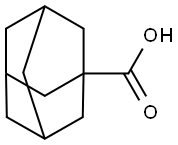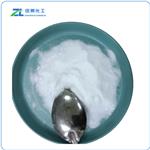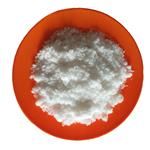Chemical Properties
white to off-white crystalline powder
Uses
1-Adamantanecarboxylic acid can be used as:
- A stabilizer in the synthesis of monodisperse, highly crystalline CoPt3?nanoparticles and porous platinum nanoparticles.
- An additive in polycondensation reactions to yield conjugated polymers as possible optoelectronic materials.
- An additive in the allylic substitution reaction, which is catalyzed by palladium in an aqueous medium.
Uses
It can be used as a stabilizer in the synthesis of monodisperse, highly crystalline CoPt3 nanoparticles1 and porous platinum nanoparticles. It is a potent and reversible CerK inhibitor.
Uses
Adamantoic Acid is an inhibitor of chorismate mutase activity and hydroxyphenylpyruvate synthase. It inhibits TTR conformational changes facilitating amyloid fibril formation.
Biochem/physiol Actions
1-Adamantanecarboxylic acid undergoes complexation reactions with cyclohexaamylose. It is an inhibitor of phenyl ester hydrolysis of cycloheptaamylose.
Purification Methods
Possible impurities are trimethylacetic acid and C9 and C13 acids. Dissolve 15g of the acid in CCl4 (300mL) and shake with 110mL of 15N aqueous NH3 whereby the ammonium salt separates and is collected. Acid impurities form soluble ammonium salts. The salt is washed with cold Me2CO (20mL) and suspended in H2O (250mL). This is treated with 12N HCl and extracted with CHCl3 (100mL). The dried (Na2SO4) extract was evaporated and the residue was recrystallised from a mixture of MeOH (30mL) and H2O (ca 10mL) to give the pure acid (10-11g). [Koch & Haaf Org Synth Coll Vol V 20 1973.] It was also recrystallised from absolute EtOH and dried under vacuum at 100o. Alternatively, the acid (5g) is refluxed for 2hours with 15mL of MeOH and 2mL of 98% H2SO4 (cool when mixing this solution). Pour into 10 volumes of H2O and extract with the minimum volume of CHCl3 to give clear separation of phases. The extract is washed with H2O, dried (CaCl2) and distilled. The methyl ester is collected at 77-79o/1mm, m 38-39o. The ester is hydrolysed with the calculated amount of N KOH and refluxed until clear. Acidification with HCl provides the pure acid with 90% recovery. The amide crystallises from cyclohexane, m 189o. [Stetter et al. Chem Ber 92 1629 1959.] [Beilstein 9 IV 253.]



